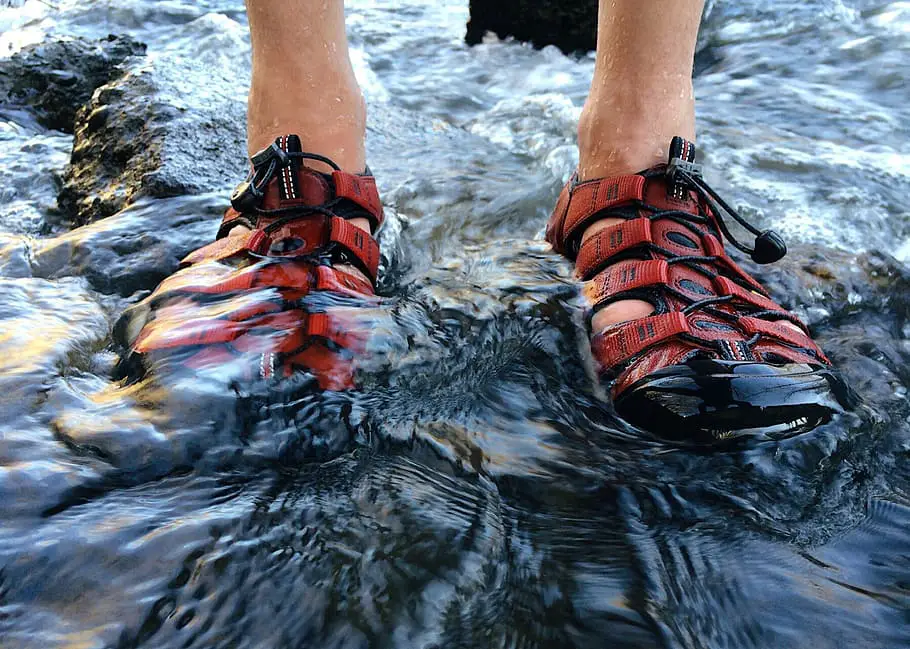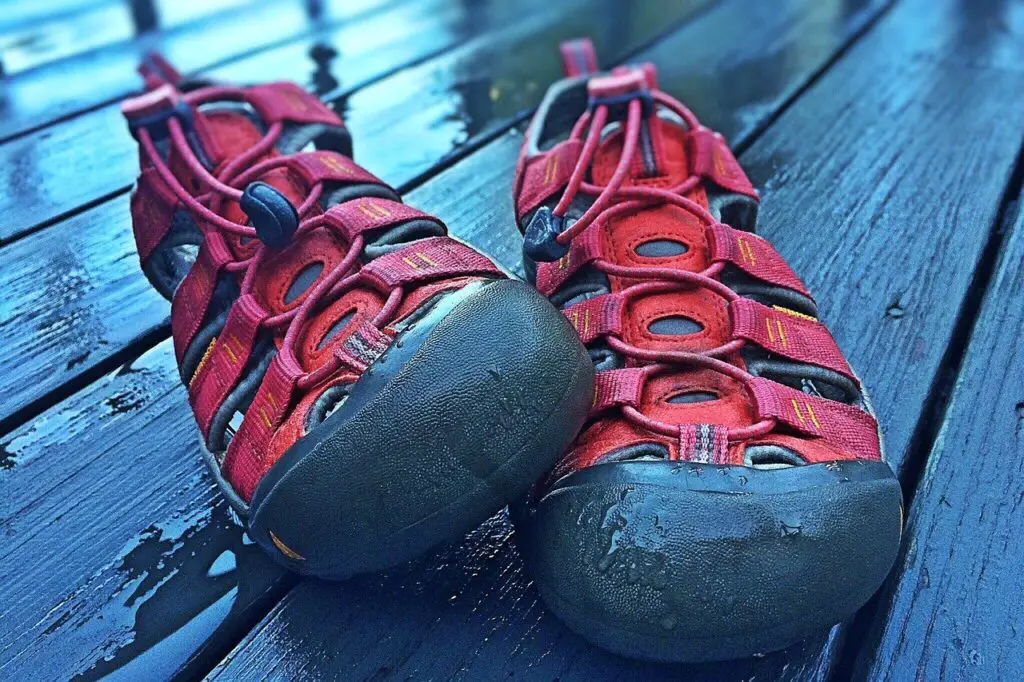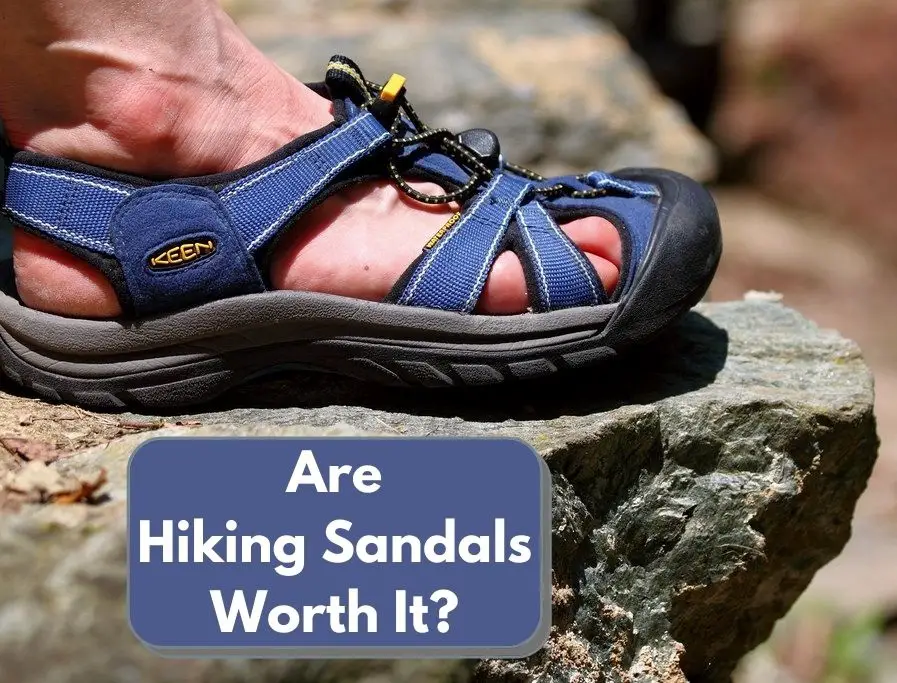As trail runners slowly grew in popularity over hiking boots in the last few years, that paved the way for other types of hiking footwear like toe shoes for hiking, minimalist hiking footwear, and hiking sandals. You may be wondering: are hiking sandals worth it?
We found that hiking sandals are not worth it due to their lack of ankle support, toe protection, and inability to keep dirt and debris away from your feet while hiking. Hiking sandals simply cannot offer the same level of protection and support that hiking boots or hiking shoes can.
However, there may be some characteristics of hiking sandals that will make them a good choice for your specific uses.
We lay out the clear pros and cons of hiking sandals along with a few good choices of what to get if you opt to go the hiking sandal route.

Are Hiking Sandals Worth It? Pros Of Hiking Sandals
Hiking Sandals Are Lightweight
Hiking sandals are much more lightweight than traditional hiking boots, and the energy expense on long hikes really adds up when you’re lugging extra weight on your feet.
Hiking sandals keep your feet light and nimble, giving you extra energy on longer treks.
Hiking Sandals Are Great For Crossing Water
There’s no need to remove your footwear and socks before crossing water or worrying about how long it’ll take for everything to dry out when you use hiking sandals.
Since sandals are open and airy, your feet and the minimal materials on your sandals will dry out in no time.
Hiking Sandals Are Highly Breathable
Hiking sandals come in open and closed-toe styles and in strap or shoe-like variants, but one common theme is that they are all open by design – they are sandals, after all.
This open design allows more air to get to your feet which keeps them cool and eliminates sweat from your feet while you hike, and many hikers enjoy that extra level of comfort.
Blisters Don’t Stand A Chance In Hiking Sandals
When your feet sweat and rub against traditional hiking footwear like boots or trail runners, they can cause friction points (or hot spots) which can eventually lead to blisters.
Sandals are good at keeping sweat and moisture at bay and the straps are easily adjustable on most models, allowing you to tackle hot spots before they become a problem.
Hiking Sandals Come Off And On Easily
It’s absurdly easy to take hiking sandals off and put them back on quickly, which allows you to get debris like small stones and sticks out of your shoe in a snap.
Hiking Sandals Are Versatile
Hiking sandals have plenty of uses outside of just hiking – their design makes them great for everyday use around town or using in wet conditions like a beach or lake.
These are places that you would never use hiking boots, but your hiking sandals are good to go!

Are Hiking Sandals Worth It? Cons Of Hiking Sandals
Hiking Sandals Leave Your Toes Exposed
Although it’s nice to have your feet cooled by the air, this freedom comes at a significant cost.
Your toes and skin on your feet are exposed to sun, heat and cold, snakes and insects, and jagged edges of rocks and roots.
Nothing’s going to end your hiking trip faster than a stubbed or broken toe or a cut on your foot, and this is the biggest drawback of hiking sandals.
The Straps On Hiking Sandals Can Rub You Raw
The straps that are on hiking sandals can cause hotspots on your feet, especially if they get wet or get sand underneath them.
If Your Hiking Sandals Fail, You’re In Bad Shape
Traditional hiking boots and hiking shoes excel here because if you break a lace or get a hole in your shoe, you can carry on with protection still intact.
That’s not the case with hiking sandals! A broken strap means the sandal will no longer function, so you’d better bring along something that can help mend your sandals in your daypack as a precaution.
Hiking Sandals Leave Your Feet Exposed To The Elements
Your toes and feet don’t get nearly as much exposure to sun as the rest of your skin, and sunburns are never comfortable anywhere on the body – especially on feet.
Hiking sandals are at a disadvantage here due to the lack of coverage on your skin.
Hiking Sandals Offer Less Grip
Although hiking sandals do offer a good amount of grip – especially in wet conditions – they simply don’t offer the same amount of traction as hiking boots can.
Take note of this and plan your hiking footwear accordingly to be best prepared for the terrain you’ll be traveling on.
The Best Hiking Sandals
Chaco Z1 Classic Hiking Sandals

Chaco’s Z1 Classic Hiking Sandals are a favorite among hiking sandal proponents due to their combination of arch support, comfort, and durability.
They feature a podiatrist-certified Luvseat footbed and a grippy sole with 3mm lug depth, which is quite good for a hiking sandal.
Keen Newport H2 Hiking Sandals

The Keen Newport H2 Hiking Sandals are an excellent pick because they pack in a lot of much-needed features in an affordable package.
The soles feature a multi-directional lug pattern for increased traction, a secure fit lace capture system, and a protective toe cap for added safety to prevent scrapes and stubs.
Teva Omnium 2 Hiking Sandals

The Teva Omnium 2 Hiking Sandals are great on and off the trail thanks to their water-ready quick-drying synthetic uppers and a buckle closure that helps them come off and on quickly.
They feature a Rugged Spider rubber outsole which is great for wet/dry conditions, a Nylon shank for extra foot support on uneven terrain, and a lightweight EVA-foam insole to add extra cushioning for comfort.
Xero Z-Trail Hiking Sandals

If you’re looking for a barefoot or minimalistic feel, look no further than the Xero Z-Trail Hiking Sandals.
These zero-drop sandals offer the perfect combination of comfort, lightweight materials, flexibility, durability, and protection in a barebones hiking sandal that is highly versatile and can be worn anywhere.
Are Hiking Sandals Worth It? Tips For Using Hiking Sandals
Break Your Hiking Sandals In
Just like breaking hiking boots in, you also need to break in hiking sandals before hitting the trail.
Wear them around the house and while doing errands to get everything properly broken in while being sure to pay attention to any hot spots during the process.
Prep Your Feet For Hiking Sandals
Building up calluses is going to help with any discomfort from getting stuff in between your sandals and your feet on the trail and also cut down on blisters.
Check out our guide on how to prepare your feet for hiking for some great tips here.
Additionally, you can pre-tape the hot spots on your feet using Moleskin, Leukotape, or Rock Tape to prevent blisters from forming while hiking.
Start Out Small With Hiking Sandals
After breaking in your hiking sandals, don’t go for a 10-hour hike! Start small, taking shorter hiking trips and building up the length gradually so you don’t accidentally overdo it.
Don’t Forget The Sunscreen
Always apply sunscreen to your feet and toes when using hiking sandals (hit the rest of your exposed skin while you’re at it).
Your toes and feet generally get less sun exposure than the rest of your skin, leaving them more prone to sunburn.
Avoid Leather Hiking Sandals
Although the majority of hiking sandals use synthetic materials, some still use leather for the materials or straps.
Leather causes more friction than synthetics and can also change in shape quite a bit when wet versus dry, so we don’t recommend hiking sandals made with leather.
Wear Socks With Your Hiking Sandals
While we could debate the fashion merits of socks and sandals all day, you’ll need to put your fashion pride aside if you want to wear your hiking sandals.
Using a pair of lightweight hiking socks with sandals gives your feet sun protection, some small extra layer of protection against insects and (maybe) snakes, and most importantly allows for a barrier between the straps of your sandals and your bare skin, cutting down on hot spots and blisters.
Are Hiking Sandals Worth It? Conclusion
As we have covered here, while hiking sandals do have their benefits, we think it’s better to stick with hiking boots or hiking shoes on the trail due to the overall safety and support benefits they offer.
If you’re planning on hiking paved or simple, short hikes on well-established trails, hiking sandals will do fine, but you’ll want to opt for hiking boots for anything more intense.
If you’ve decided to go the hiking boot route, check out our guides on how should hiking boots fit and our top picks of best men’s hiking boots under $100 and best women’s hiking boots under $100 while you’re here.
What is your favorite hiking footwear? Let us know in the comments below.
Thanks for reading, and enjoy the hike!

